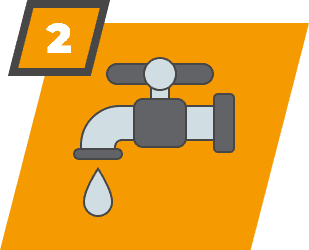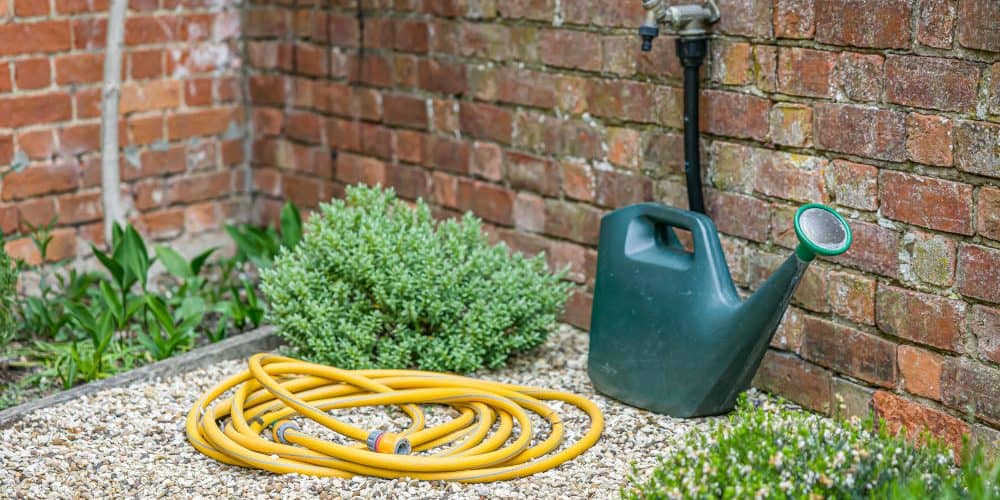If you have turned on your garden tap for the first time in a while to find it isn’t working, there could be several reasons for this. The most probable cause is either the washer needs replacing or the tap body itself needs servicing. The worst-case scenario would be the complete outside tap needs replacing, but fear not, it is a relatively simple job for a professional plumber. We look at some of the most common problems and solutions to help get your garden hose up and running as soon as possible. Fitting an outside tap is essential for efficient watering and garden maintenance, ensuring your outdoor space stays functional and accessible.
No water is coming out the garden tap at all
If you have an outside tap with no water coming out, you can:
Check if there is water supply to your garden tap
Test other taps in your home and, if there is no water flow anywhere, the problem may lie with the main water supply. In this case, contact your water provider to report the issue and gain assistance.


Make sure the isolating valve on the water supply pipe to the outside tap is open and unblocked.
Sometimes, the valve supplying water to the garden tap has accidentally been closed, causing the lack of water flow. If the valve is open (in line with the pipe), check for any blockages in the valve or the pipe leading to the tap. Remove any debris or sediment that might be obstructing the flow.
Check the pipes are not frozen.
If your garden tap stops working during freezing temperatures, frozen pipes could be the culprit. Inspect the pipes leading to the garden tap for signs of freezing (frost or ice build-up). Thaw the pipes by using a heat source on the frozen section, we recommend using a professional plumber for this to avoid damaging the pipe. Insulating the pipework will help prevent pipes becoming frozen in the first place – more on that later. Here you can understand how to unfreeze a frozen condensate pipe from expert’s advice on dealing with similar issues.


Unclog blocked taps.
Sediment, dirt, or debris can accumulate inside the tap itself, leading to blockages. Therefore, removing the tap aerator or nozzle and cleaning it thoroughly could be the solutions. Plus, if the tap has a built-in filter, check and clean it as well. If a clogged-up tap or filter is the cause, cleaning it should improve water flow.
Inspect for leaks or pipe damage.
Don’t forget to check the water supply pipes for any visible leaks or damage. A leak or a burst pipe can disrupt the water flow to the tap. If you find any leaks, turn off the water supply and contact a professional plumber to repair or replace the damaged section.


Consider pressure issues.
Low water pressure in your area can affect the flow of water to your garden tap. Contact your local water authority or water company to enquire about any ongoing maintenance or issues that might be affecting the water pressure in your local area. It’s also worth checking if a tap washer replacement is needed, as a worn washer can contribute to poor water flow.
Garden tap not working after freezing temperatures.
During winter, the cold can take its toll on our outside taps and pipework. If you find your outside tap stops working after a freezing winter, it is likely that it is a result of one of the following:
1
A damaged or stuck double check valve.
A double check valve protects the outside tap from contaminating the water supply. The addition of a hosepipe to a garden tap that could potentially be submerged in water (such as ponds, paddling/swimming pools, tanks), creates the risk of backflow and therefore contamination to the mains water supply. The valve should be installed close to the water outlet and will allow water to flow in one direction (to your tap) by forcing a spring open inside the valve. However, if the water tries to flow in the opposite direction (back into your home) the spring closes to prevent this from happening.
During extremely wintry weather, it is common for the valve to become stuck or damaged, which means it will need to be cleaned or, if the garden tap has the double check valve built in, replaced.
2
The pipework is frozen.
If the water in the pipework leading to your garden tap is frozen, you will need to thaw the pipe with a heat source to get things flowing again. To prevent this from happening in the first place, it is important to insulate the exterior pipework that runs to the tap. When water freezes, it expands, so a frozen pipe could lead to a burst pipe – which is costly, inconvenient, hazardous, and disruptive. Insulating pipework is a job well worth doing. Fitting an outside tap cover for the winter will also reduce the chances that your garden tap will freeze.
If you encounter an issue where your garden tap won’t turn off, it’s essential to address it promptly. Seeking professional advice for troubleshooting can ensure a swift resolution and prevent further water waste.
Garden tap is trickling water and will not turn off completely.
If you have water dribbling from your outside tap despite it being ‘off,’ it suggests a damaged washer problem. Replacing the washer typically solves the problem but if it doesn’t, you may need to replace the whole tap body.
Preventative measures include ensuring you don’t over tighten the tap when you turn it off. As well as protecting the installation from freezing. If water trapped in the tap freezes, it will cause the rubber washer to quickly deteriorate and perish. Ensure you insulate the tap and pipework and leave the water supply isolated with the tap open during the winter months.
Domestic installations can sometimes seem straightforward, but if you are not confident with plumbing projects, they can suddenly feel complex. It is always worth giving a professional a call. After all, small water leaks and tap issues can often become bigger, more costly issues if not dealt with quickly, not to mention a great waste of water. The Maintracts team are here for you if you need them.
P.S. Ever considered harvesting rainwater to help reduce your water consumption in the garden? Check out our blog on why rainwater harvesting is worth investing in to help you weigh up the pros and cons.

